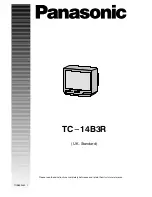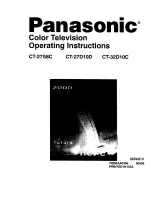
- 5 -
Service Notes (Continued)
IMPORTANT: To protect against possible damage to
the solid state devices due to arcing or static discharge,
make certain that all ground wires and CTR DAG wire
are securely connected.
CAUTION: The power supply circuit is above earth
ground and the chassis cannot be polarized. Use an
isolation transformer when servicing the Receiver to
avoid damage to the test equipment or to the chassis.
Connect the test equipment to the proper ground ( ) or
(
) when servicing, or incorrect voltages will be
measured.
WARNING: This Receiver has been designed to meet
or exceed applicable safety and X-ray radiation
protection as specified by government agencies and
independent testing laboratories.
To maintain original product safety design standards
relative to X-ray radiation and shock and fire hazard,
parts indicated with the symbol
on the schematic
must be replaced with identical parts. Order parts from
the manufacturer’s parts center using the parts
numbers shown in this service manual, or provide the
chassis number and the part reference number.
For optimum performance and reliability, all other parts
should be replaced with components of
identical specification.
Horizontal Oscillator Disable Circuit
This chassis employs a special circuit to protect
against excessive high voltage and beam current. If, for
any reason, the high voltage and beam current exceed
a predetermined level this protective circuit activates
and detunes the horizontal oscillator that limits the high
voltage. The over-voltage protection circuit is not
adjustable. However, if components indicated by the
symbol
on the schematic in either the horizontal
sweep system or the over-voltage protection circuit
itself are changed, the operation of the circuit should be
checked using the following procedure:
Equipment needed to check the disabled circuit:
1. Voltmeter (0 - 200V scale)
2. High Voltage Meter (0- 50kV)
3. Variac or Isolation Transformer
Procedure:
1.
Tune in a station to verify that the horizontal is
in sync.
2.
Obtain a Monoscope pattern or a signal generator
crosshatch pattern
3.
Connect the voltmeter (-) lead to TPD2 and the (+)
lead to TPD1 (junction of D555 anode, R556 &
R557). Set Bright level to (0) and Picture for a 1.8
volt reading on the voltmeter.
4.
Turn the Receiver OFF. Connect a jumper across
IC803 pin 3 and pin 4.
5.
Reduce the AC supply voltage to approximately
45V. Connect the high voltage meter to the CRT
anode (H.V. button).
Note: Use the Dag Ground (C10 on the CRT Board)
to connect the (-) lead of the meter.
6.
Turn the Receiver ON. Slowly increase the AC
supply voltage and verify that the high voltages
does not exceed 35.1kV for 25” models and
37.1kV for 27” models, 39.3kV for 32” models
when horizontal just begins to pull out of sync. If
the high voltage is not within the specified limit, the
cause must be determined and corrected before
the receiver is returned to the costumer.






































